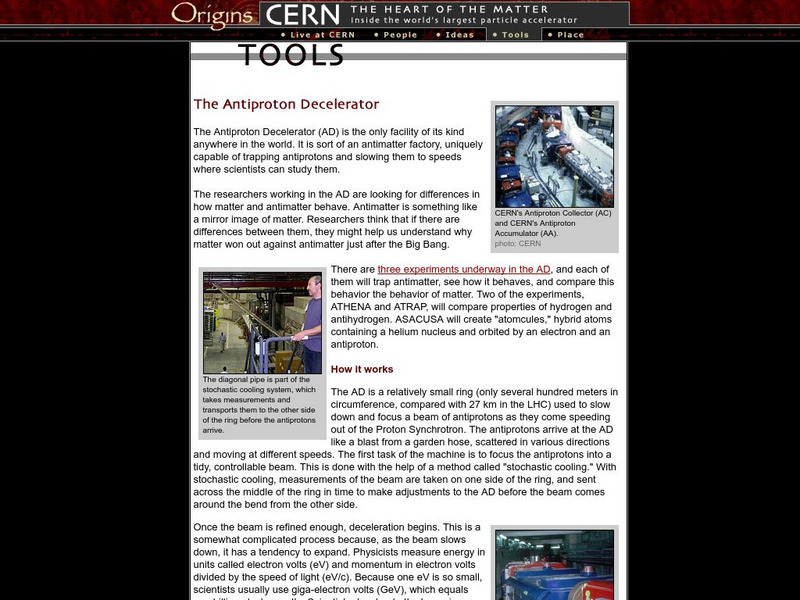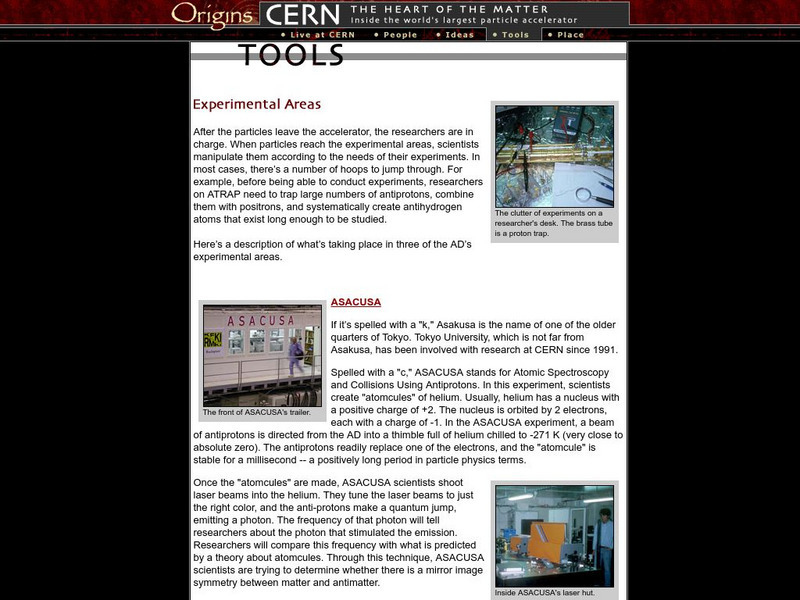PBS
Pbs: A Science Odyssey
Website for the PBS series "A Science Odyssey." Numerous opportunities to explore the people and discoveries of science.
Lawrence Berkeley National Laboratory
Berkeley Lab: Particle Adventure: Matter and Antimatter
The beginning of an informative tutorial on antimatter, covering quarks, hadrons, baryons, mesons, leptons, and neutrinos.
American Association for the Advancement of Science
Fermilab Physicists Find New Matter Antimatter Asymmetry
This complicated yet interesting article describing the discovery of asymmetry between the behavior of matter and antimatter.
Other
Ippog: Hands on Particle Physics
Looking for more insight into particle physics? Search among several general particle physics resources. Or locate a specific particle physics institute in your area of the world.
Vision Learning
Visionlearning: Dalton's Playhouse
Travel back in history and visit the laboratories of Priestley, Lavoisier, and others. Take part in simulations of the experiments which laid the foundation for the scientific field of chemistry. Learn about the discoveries which lead to...
CK-12 Foundation
Ck 12: The Nuclear Model of the Atom
[Free Registration/Login may be required to access all resource tools.] In the following online tutorial students will distinguish between the three main subatomic particles and understand the contributions of J. J. Thomson, Robert...
CK-12 Foundation
Ck 12: Isotopes and Atomic Mass
[Free Registration/Login may be required to access all resource tools.] In the following online tutorial students will be asked to define atomic number, mass number and understand how isotopes differ from one another. They will be able...
CK-12 Foundation
Ck 12: Flex Book Textbooks: Chemistry Second Edition
[Free Registration/Login may be required to access all resource tools.] A complete, web-based, multi-media textbook covering a wide variety of Chemistry concepts.
Khan Academy
Khan Academy: Dalton's Atomic Theory
An article describing Dalton's atomic theory. Learn how this theory was the first attempt to describe a fundamental part of matter, atoms. Article also discusses where the theory is incorrect based on the knowledge we have today.
Khan Academy
Khan Academy: Dalton's Atomic Theory
Article explores the key points of Dalton's atomic theory and the laws of conservation of mass and constant composition. Which points do we still use today?
Texas Education Agency
Texas Gateway: Matter and Energy: Atomic Structure
This tutorial reviews over the basics of atomic structure.
Nobel Media AB
The Nobel Prize: J. J. Thomson Biographical
Read this detailed Nobel E-Museum biography which includes information on the scientific world of Joseph John Thomson, which gained world-wide recognition and earned Thomson the Nobel Prize in Physics.
University of St. Andrews (UK)
University of St. Andrews: Werner Heisenberg
German born Werner Heisenberg was a notable physicist who worked on numerous projects, including quantum theory.
Nobel Media AB
The Nobel Prize: The Nobel Peace Prize 1962
Read about Linus Carl Pauling, the winner of the 1962 Nobel Peace Prize. This website is organized into the following sections: "Presentation Speech," "Biography," "Nobel Lecture," "Other Resources," and "The Nobel Chemistry Prize 1954."
TeachEngineering
Teach Engineering: Mixtures and Solutions
This unit covers introductory concepts of mixtures and solutions. Students think about how mixtures and solutions, and atoms and molecules can influence new technologies developed by engineers. The first lesson explores the fundamentals...
University of St. Andrews (UK)
University of St. Andrews: Wolfgang Pauli
Check out this short look at the life of 1945 Nobel Prize winner, Wolfgang Pauli. Make sure to look at all the links at the bottom of the page too.
Chiral Publishing
Chiral Publishing: An Introduction to Chemistry: Modern Atomic Theory [Pdf]
The modern atomic theory chapter from "An Introduction to Chemistry", describes electrons, electron orbitals, and how to draw orbital diagrams. Many pictures and examples help to explain the information. Also find a detailed chapter...
American Chemical Society
Middle School Chemistry: Protons, Neutrons, and Electrons
Investigate why a charged object is attracted or repelled by another charged object. Explore the concept that the attraction between positive protons and negative electrons holds an atom together.
CK-12 Foundation
Ck 12: Atomic Theory
[Free Registration/Login may be required to access all resource tools.] In this online tutorial students will explain the law of conservation of mass, the law of definite proportions, and the law of multiple proportions. They will also...
Utah Education Network
Uen: Timeline for the Atom
Students will examine how significant scientific theories are developed, explore the work of scientists who contributed ideas to the atomic theory, and develop a timeline of key scientists to show how the work of each one built on the...
Exploratorium
Exploratorium: Cern: The Antiproton Decelerator
Explains the function of the Antiproton Decelerator, a device at the European Center for Nuclear Research used to "slow down" bunches of antiprotons for use in experiments.
Exploratorium
Exploratorium: Cern: Experiments With Antimatter
A description of the two primary experiments conducted at CERN on antimatter: ASACUSA, an attempt to form "Atomcules," using antiprotons; and ATHENA, an experiment to compare the properties of hydrogen and antihydrogen.
Chiral Publishing
Chiral Publishing: An Introduction to Chemistry: Modern Atomic Theory: Study Guide [Pdf]
This study guide provides an overview of the modern atomic theory chapter from "An Introduction to Chemistry. Find chapter goals, map, checklist, web resources and the answer key to the chapter review.
Chiral Publishing
Chiral Publishing: An Introduction to Chemistry: Modern Atomic Theory: Power Point [Pdf]
This power point highlights the main ideas about modern atomic theory from the online textbook "An Introduction to Chemistry". Step by step instructions are given to write electron configurations and draw orbital diagrams. Also includes...



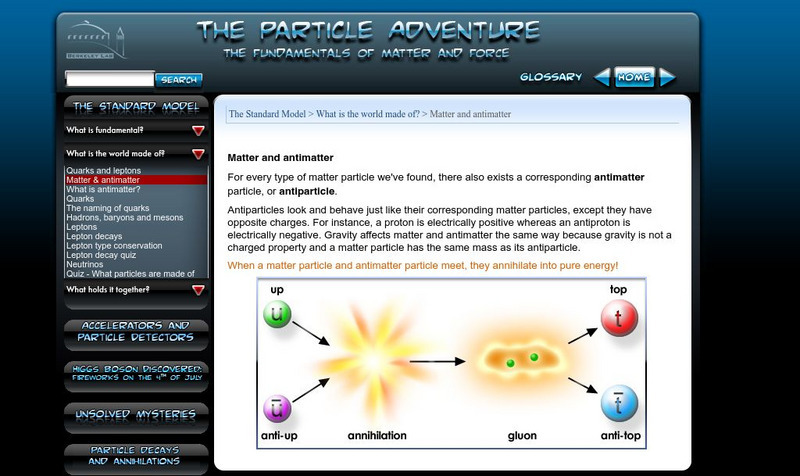




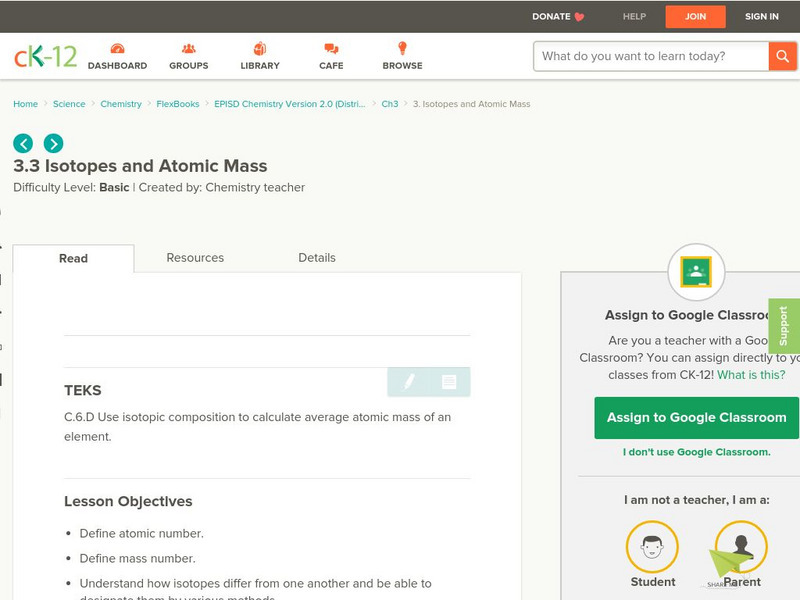







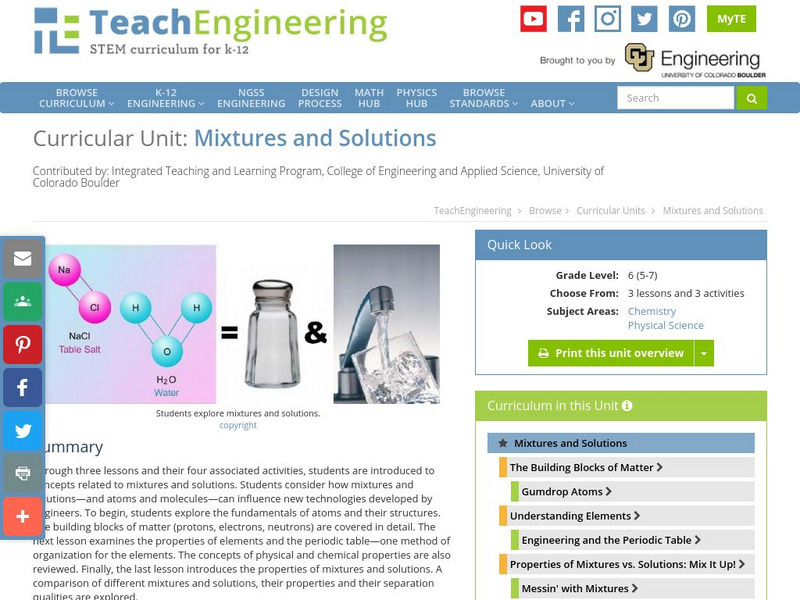

![Chiral Publishing: An Introduction to Chemistry: Modern Atomic Theory [Pdf] eBook Chiral Publishing: An Introduction to Chemistry: Modern Atomic Theory [Pdf] eBook](https://d15y2dacu3jp90.cloudfront.net/images/attachment_defaults/resource/large/FPO-knovation.png)

